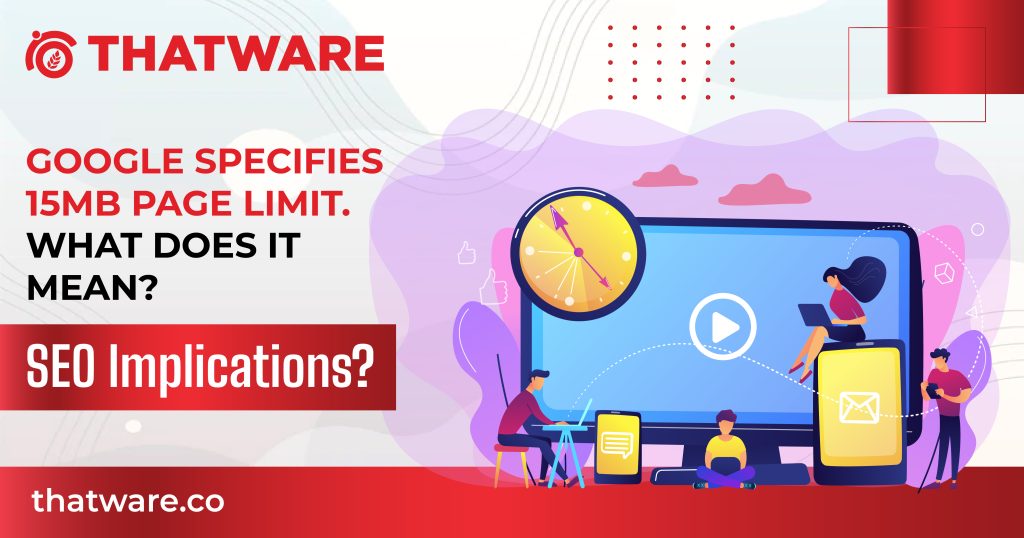SUPERCHARGE YOUR ONLINE VISIBILITY! CONTACT US AND LET’S ACHIEVE EXCELLENCE TOGETHER!
Page Performance and Page SIze have always been primary KPIs while monitoring and optimizing the technical aspects of SEO.
Recently, Google released a document in Search Central, about this and specified the following about Page size limits.

“Namely, we’ve documented that Googlebot only ever “sees” the first 15 megabytes (MB) when fetching certain file types.“
However, the biggest question in the SEO community is revolving around whether the page size limit includes images, videos and other resources as well.
Understanding Google’s Indexing Process
Understanding Google’s indexing process is crucial for anyone seeking to maximize their online presence and ensure that their web pages are effectively discovered and ranked by the world’s most popular search engine. At its core, Google’s indexing process involves two main stages: crawling and discovering web content, and indexing and storing web pages in Google’s vast database.
A. How Google Indexes Web Pages
Crawling and Discovering Web Content:
Google employs automated programs known as “spiders” or “crawlers” to systematically browse the internet and discover new web pages. These crawlers follow links from one page to another, continually traversing the interconnected network of the World Wide Web. When a crawler encounters a new web page, it analyzes the page’s content, structure, and metadata to determine its relevance and importance.
Key Points:
- Crawlers use algorithms to prioritize which pages to visit based on factors like page rank, recency of content updates, and authority of the website.
- XML sitemaps and internal linking structures play a crucial role in guiding crawlers to important pages within a website.
Indexing and Storing Web Pages in Google’s Database:
Once a crawler accesses a web page, it extracts and processes the page’s content, including text, images, and other multimedia elements. This information is then added to Google’s index, a massive database containing information about billions of web pages. Google’s index serves as the foundation for its search results, enabling users to quickly find relevant information in response to their queries.
Key Points:
- Google’s index is continuously updated as crawlers discover new pages, revisit existing ones, and detect changes to page content.
- Pages that meet Google’s quality guidelines and provide valuable, relevant content are more likely to be indexed and ranked prominently in search results.
B. Importance of Page Size in Indexing
Impact on Crawlability and Indexing Efficiency:
The size of a web page can significantly influence its crawlability and indexing efficiency. Large pages with extensive content, complex structures, or numerous multimedia elements may take longer for crawlers to process and index. As a result, excessively large pages may experience delays in being fully indexed or may be indexed incompletely.
Key Points:
- Google recommends keeping web page sizes reasonable to ensure efficient crawling and indexing.
- Large pages should be optimized to prioritize the most important content and reduce unnecessary bloat, such as oversized images or excessive JavaScript code.
Factors Influencing Google’s Indexing Decisions:
Google’s indexing decisions are influenced by various factors, including page size, relevance, authority, and user experience. While page size alone does not determine whether a page will be indexed, excessively large pages may be deprioritized in favor of smaller, more streamlined alternatives.
Key Points:
- Google aims to provide users with a diverse range of high-quality content in its search results.
- Pages that offer valuable, well-organized content in a user-friendly format are more likely to be indexed and ranked favorably by Google.
Understanding Google’s indexing process and the importance of page size therein is essential for website owners, marketers, and content creators alike. By optimizing web pages for efficient crawling, indexing, and user experience, businesses can increase their visibility in search results and attract more organic traffic to their websites.
What does the Size Limit Correspond to?
Here’s what John Muller had to say about it.
“It’s specific to the HTML file itself like it’s written.Embedded resources/content pulled in with IMG tags is not a part of the HTML file.”
Rest assured there is no cause for concern. 15 MB is a reasonably large file size the recommended file size for HTML pages is not more than 100KB.
Whenever we open a new website, our browser first downloads the HTML page as it is. Based on the HTML contents it makes additional requests for other resources. So rest assured all Images and videos that are referenced by the img and video tags are indexed separately.
For example: <img src=”https://example.com/images/puppy.jpg” alt=”cute puppy looking very disappointed” />
So if you are being a good SEO and following all of its best practices, you shouldn’t be having a problem. There are a few pages on the internet of that size, and you may never encounter one unless you want to fit an entire book within a single page.
What are its SEO Implications?
This update however does not change the Status Quo of the SEO Best Practices. The best practice still dictates the recommended page size to be 100KB. The 15 MB threshold was present previously, only that it was never officially announced. The recent article changes that.
Read full article > https://developers.google.com/search/blog/2022/06/googlebot-15mb
However, if your page is media-heavy and contains a lot of resources, it probably would be wise to perform certain tasks.
The following steps might help in Indexing a page near to or exceeding 15MB including resources:
- The HTML code must be structured in a way that all SEO Relevant content stays on the upper side of the page.
- The images and videos should be compressed and not directly related to the Web Pages.
Although putting a limit to the page size may sound worrisome, however, 15MB is a reasonably high size for a page.
If you Ever have Pages with more size than 15MB you probably would have other underlying issues.
Future Trends and Considerations
Google’s page size limit involves examining its potential impact on web development practices, anticipating the evolution of Google’s indexing algorithms and criteria, and exploring emerging technologies and approaches for optimizing page size and performance.
A. Potential Impact of the Page Size Limit on Web Development Practices
Google’s implementation of a page size limit for indexing is likely to influence how websites are developed and optimized in the future. Web developers will need to prioritize page size optimization as a fundamental aspect of website design and development. This shift in focus may lead to changes in coding practices, resource management, and content delivery strategies.
One potential impact is a greater emphasis on modular and lightweight web components. Developers may adopt techniques such as code splitting, lazy loading, and resource prioritization to reduce the initial page payload and improve loading times. Additionally, optimizing images, scripts, and other assets will become standard practice to ensure compliance with Google’s page size guidelines.
The page size limit may prompt the adoption of alternative technologies and frameworks that prioritize performance and efficiency. Lightweight frameworks, serverless architectures, and content delivery networks (CDNs) may see increased adoption as developers seek to optimize page size and improve website performance.
B. Evolution of Google’s Indexing Algorithms and Criteria
Google’s indexing algorithms and criteria are continually evolving to reflect changes in user behavior, technological advancements, and the evolving landscape of the web. The introduction of a page size limit is just one example of how Google adapts its algorithms to prioritize user experience and relevance.
In the future, we can expect Google to place even greater emphasis on page speed, mobile-friendliness, and overall user experience as ranking factors. This may lead to further refinements in how Google evaluates and indexes web pages based on their performance metrics, including page size, loading speed, and interactivity.
Google may introduce new tools and resources to help webmasters monitor and optimize page size and performance effectively. This could include enhancements to Google Search Console, PageSpeed Insights, and other developer tools to provide actionable insights and recommendations for improvement.
C. Emerging Technologies and Approaches for Optimizing Page Size and Performance
As web development practices continue to evolve, new technologies and approaches for optimizing page size and performance are emerging. These innovations aim to address the challenges posed by increasing page complexity, multimedia content, and user expectations for fast and responsive web experiences.
One emerging technology is WebAssembly, which allows developers to run high-performance, low-level code directly in the browser. WebAssembly enables more efficient execution of computationally intensive tasks, reducing the need for large JavaScript bundles and improving overall page performance.
Advances in image and video compression algorithms are enabling more efficient delivery of multimedia content while maintaining visual quality. Technologies such as AVIF (AV1 Image File Format) and HEIC (High Efficiency Image Format) offer superior compression compared to traditional image formats like JPEG and PNG, reducing file sizes and improving page load times.
Serverless architectures and edge computing are gaining traction as scalable and efficient solutions for delivering dynamic content and applications. By leveraging serverless platforms and CDNs, developers can optimize content delivery and reduce latency, resulting in faster page load times and improved user experiences.
The future of web development will be shaped by the need to optimize page size and performance in accordance with Google’s indexing guidelines and evolving user expectations. By embracing emerging technologies and best practices for optimization, developers can create faster, more efficient, and more engaging web experiences for users worldwide.
How to Measure Page SIze and perform Technical Analysis
There are many tools that can measure page size. Any one of them can be referred to while finding page size.
Tools to measure Page Size
- Google Page Speed Insights.
- GTMetrix
- Screaming Frog(Best option)
You can also check the Page Size using Chrome Developer Tools:
However, analyzing technical issues with your website might require a full-scale crawl.
Tools to Perform Technical Analysis
- SERanking
- SEOOptimer
- SEMRush
- Ahrefs
- SEOSiteCheckUp
How to Measure Page Size and Perform Technical Analysis
In today’s digital landscape, understanding the technical aspects of your website is crucial for ensuring optimal performance, user experience, and search engine visibility. One of the fundamental aspects of website performance is page size. Page size refers to the total amount of data that needs to be loaded when a user visits a specific webpage. It includes all the resources such as HTML files, CSS stylesheets, JavaScript files, images, videos, and other multimedia elements. Measuring page size and conducting a thorough technical analysis can help identify areas for optimization, improving loading speed and overall website efficiency.
Tools to Measure Page Size
There are several tools available to help measure page size. Each tool has its unique features and capabilities, but they all serve the same purpose: to give you an accurate understanding of how large your webpage is and where optimizations might be necessary. Below are some of the most effective tools for measuring page size:
1. Google PageSpeed Insights
Google PageSpeed Insights is one of the most popular tools for measuring page size and assessing website performance. It provides detailed insights into your webpage’s loading speed and highlights the size of different resources. Additionally, it offers actionable recommendations to improve page speed and reduce page size.
Key Features:
- Measures page size for both mobile and desktop versions.
- Identifies specific elements contributing to large page sizes.
- Provides suggestions to optimize images, CSS, JavaScript, and server response times.
Why Use It: Google PageSpeed Insights is backed by Google, making it a reliable and widely recognized tool. It is also free to use and easily accessible.
2. GTMetrix
GTMetrix is another excellent tool for measuring page size and analyzing website performance. It provides a comprehensive breakdown of the components contributing to your page size and includes visual insights such as waterfall charts and performance grades.
Key Features:
- Offers a detailed breakdown of page size by resource type (e.g., images, scripts, fonts).
- Includes a waterfall chart to visualize loading times and bottlenecks.
- Provides recommendations for reducing page size and improving performance.
Why Use It: GTMetrix’s user-friendly interface and detailed reporting make it an ideal choice for web developers and marketers seeking in-depth insights.
3. Screaming Frog (Best Option)
Screaming Frog is a powerful website crawler and one of the best tools for measuring page size. While its primary purpose is technical SEO analysis, it also provides valuable insights into page size and the resources contributing to it.
Key Features:
- Crawls entire websites to identify page sizes for all URLs.
- Highlights large resources such as images or scripts.
- Offers exportable data for further analysis.
Why Use It: Screaming Frog is the best option for large-scale website analysis, especially for websites with multiple pages. Its ability to crawl and analyze all aspects of a website’s structure makes it a versatile and indispensable tool.
4. Chrome Developer Tools
If you prefer a built-in solution, Chrome Developer Tools is an excellent choice. This tool is available in the Google Chrome browser and allows you to inspect individual pages and analyze their size and performance.
How to Use It:
- Open the webpage you want to analyze in Chrome.
- Right-click on the page and select Inspect or press Ctrl+Shift+I (Windows) or Cmd+Option+I (Mac).
- Navigate to the Network tab.
- Reload the page and check the bottom panel to see the total page size.
Why Use It: Chrome Developer Tools is convenient, free, and does not require additional software. It’s perfect for quick checks and basic analysis.
Why Technical Analysis is Important
While measuring page size is essential, it is only one piece of the puzzle. A comprehensive technical analysis is necessary to identify deeper issues affecting your website’s performance, crawlability, and user experience. Technical analysis helps uncover hidden problems that may not be immediately visible, such as broken links, duplicate content, missing meta tags, and slow server response times. Addressing these issues can significantly enhance your website’s SEO and overall functionality.
Tools to Perform Technical Analysis
To perform a thorough technical analysis of your website, you need specialized tools capable of crawling and analyzing various aspects of your site. Here are some of the best tools for technical analysis:
1. SERanking
SERanking is an all-in-one SEO platform that includes a powerful website auditing tool. It helps identify technical issues, monitor page size, and optimize your website for search engines.
Key Features:
- Comprehensive website audit with detailed reports.
- Identifies issues related to page size, loading speed, and mobile usability.
- Provides actionable recommendations to fix technical problems.
Why Use It: SERanking is user-friendly and suitable for both beginners and professionals. It offers a well-rounded solution for technical analysis and ongoing monitoring.
2. SEOOptimer
SEOOptimer is a straightforward tool designed for quick website audits. It evaluates your site’s technical health and provides insights into page size, loading speed, and other performance metrics.
Key Features:
- Quick and simple website analysis.
- Highlights technical issues and optimization opportunities.
- Provides a scorecard for your website’s performance.
Why Use It: SEOOptimer is ideal for small businesses and individuals looking for an easy-to-use tool to improve their website’s technical performance.
3. SEMRush
SEMRush is a widely used SEO and marketing tool that includes a robust website auditing feature. It helps identify technical issues, including those related to page size and resource optimization.
Key Features:
- In-depth website audit with a focus on technical SEO.
- Detects issues such as slow-loading pages, oversized images, and broken links.
- Tracks performance improvements over time.
Why Use It: SEMRush is a versatile tool that offers more than just technical analysis, making it a great choice for businesses with comprehensive SEO and marketing needs.
4. Ahrefs
Ahrefs is a powerful tool known for its backlink analysis and SEO capabilities. It also includes a website auditing feature that helps identify technical issues, including page size optimization.
Key Features:
- Detailed crawl reports highlighting technical issues.
- Focus on resource optimization and load times.
- Comprehensive data visualization for better insights.
Why Use It: Ahrefs is perfect for advanced users who need a detailed understanding of their website’s technical health and SEO potential.
5. SEOSiteCheckUp
SEOSiteCheckUp is a beginner-friendly tool designed for quick technical analysis. It provides a clear overview of your website’s performance and highlights key issues.
Key Features:
- Easy-to-read reports with actionable insights.
- Focus on basic technical SEO elements like page size, loading speed, and mobile responsiveness.
- Weekly monitoring and reporting.
Why Use It: SEOSiteCheckUp is great for users who want a simple and straightforward solution for technical analysis without overwhelming complexity.
Final Thoughts
Measuring page size and performing a comprehensive technical analysis are vital steps in maintaining a high-performing website. By using the tools mentioned above, you can gain valuable insights into your website’s performance and identify areas for improvement. Start by measuring your page size with tools like Google PageSpeed Insights or Screaming Frog, and then dive deeper into technical analysis with tools like SEMRush or Ahrefs. Regular monitoring and optimization will ensure your website remains fast, efficient, and user-friendly, ultimately leading to better search engine rankings and increased user satisfaction.

Thatware | Founder & CEO
Tuhin is recognized across the globe for his vision to revolutionize digital transformation industry with the help of cutting-edge technology. He won bronze for India at the Stevie Awards USA as well as winning the India Business Awards, India Technology Award, Top 100 influential tech leaders from Analytics Insights, Clutch Global Front runner in digital marketing, founder of the fastest growing company in Asia by The CEO Magazine and is a TEDx speaker and BrightonSEO speaker.

